Bach and the Recorder
Nik Tarasov
Part 1: Johan Sebastian Bach in Mühlhausen, Weimar, Köthen
Johann Sebastian Bach is surely the most famous composer to have specified the use of the recorder in his compositions. However, nothing in the large quantity of literature on Bach makes the tracing of these works particularly easy. Nik Tarasov’s paper therefore provides a practical and up-to-date guide to one of the most important chapters in the recorder repertoire, listing Bach’s compositions in complete chronological order.
Bach himself referred to the use of recorders in 1730, writing “das KirchenStück auch mit Flöten, (sie seynd nun à bec oder Traversieri), componiret ist (wie denn sehr offt zur Abwechslung geschiehet)” [“church music has also been composed for flutes (à bec or Traversieri) ¬- as often happens for variety”]. He is referring mainly to cantatas for use in church services. Indeed, the recorder is used in about a tenth of Bach’s surviving cantatas, contributing to very moving and emotional musical scenarios. There were many other opportunities for the composer to come into contact with the recorder: in his various employments and the ensembles that he was associated with, such as court orchestras, in contact with professional musicians such as violinists and town musicians and also in lectures for students, pupils, and amateurs. Bach knew how to use the baroque recorder very effectively in chamber music as well as in orchestral works.
The instrument itself is easy to identify. Bach refers to the recorder simply as “Flauto” (with a few slightly differing spellings) and always implies the alto/treble recorder. He occasionally adds “piccolo” – and then refers to a smaller sized recorder. Also clef, range and key signature are additional means of identification. Bach always distinguishes the flute as “Traversière”.
In order to get a better understanding of Bach’s use of the recorder his compositions will be put into a complete chronological order for the first time.
It becomes obvious that between 1707 and 1717 the use of the recorder is restricted to church cantatas; in the following period (1717 – 1723) during his time in Köthen he makes use of the recorder in instrumental works. Later in Leipzig (1723 – 1750) he focuses again on cantatas.
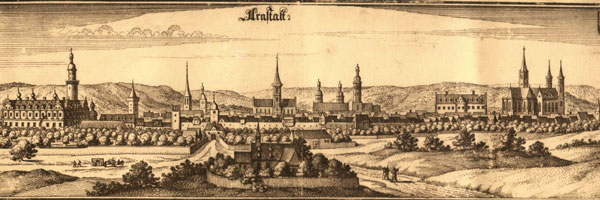
Arnstadt, view of the city. Copperplate engraving, Merian 1650. Source: Collection of the Bachhaus Eisenach/Neue Bachgesellschaft.
JohanSebastian Bach: Cantatas
Cantatas, written for a Sunday service or some other church festivity, were regarded as works for a particular purpose with the option of being re-used in the yearly cycle of church events. In the baroque era composers were expected as part of their contract to regularly write and perform church music that was suitably adapted to their local conditions and performers. Many composers worked in different places in the course of their career and re-used some older works, possibly in updated versions.
It has to be considered that even Bach’s cantatas, as they have survived, might not represent the best possible version because the composer might have had to adjust an earlier work to a particular (later) situation. Because of this, a thorough knowledge of the subject is very important not just for conductors but also for recorder players so that they know in which versions recorders are required or desired. Works that might hypothetically be suitable for recorders will be considered in Part Two of this study.
The diversity of historical and modern tunings and the effect this has had on the choice of instruments presents a further complication. It is unlikely that the historical situations will be re-enacted nowadays, but instead, just as in the past, the most practical solution – according to the available musical resources – will be chosen. In this context a knowledge of historical performance practice is very useful. The study of individual Bach cantatas leads to interesting observations, bearing in mind that in the Baroque era recorders were considered to provide a certain sound colouring and were often used in an allegorical context. Bach often uses recorders playing in unison, thus strengthening the specific instrumental part (in a similar way as specifying a particular organ register), although he uses louder instruments in this way as well. Very often this is done for a particular effect, as closer study will reveal.
JohanSebastian Bach in Mühlhausen: 1707–1708
Bach’s second appointment was the post of organist in Mühlhausen. Before this, he had worked in Arnstadt (1703–07) where he had not been very happy. The local music opportunities had been poor and not suitable for establishing “a well regulated church music to honour God”. One cause for arguments with his employers was that he had taken a three-month extension to his holiday which he used to further his studies in Lübeck. Additionally, the files of Arnstadt contain complaints about his peculiar way of playing the organ (“wunderliche variationes”, “viele frembde Thone mit eingemischet, dass die Gemeinde darüber confudiret worden” [“fantastic variations”, “with many strange notes mixed in so that the congregation became confused”]), the fact that he hadn’t composed anything himself and that he had taken a strange young lady into the organ loft. Also, on one Sunday he had visited the wine cellar during the sermon. The new employment in Mühlhausen (1707–08) must have given Bach the necessary freedom to provide at least a few compositions for private and public occasions.
The cantata “Gottes Zeit ist die allerbeste Zeit” BWV 106, was probably composed for 10/8/1707, and has been described as actus tragicus, i.e. funeral music. It is scored for a small ensemble consisting of two treble recorders and two viola da gambas with choir voices, solo tenor and bass voices, and, of course, basso continuo.
In this composition the instruments were treated in the same touching and masterful way as the overall compositional concept, which is described in detail elsewhere. For the recorders two aspects should be pointed out: a tricky unison section for the two recorders has repeated short breaks where they try to escape from the unison into separate parts. There is a long unison trill between low G and A flat, one of the weakest sounds on the historic recorder, because of the half-holing. This is very delicate and leads, most probably, to some adventurous tremulants, just as the taxing rhythmical interchange of low G and A-flat. In contrast to Bach’s later works, the tonal centre of the instrument lies in the lower octave. This was the case in recorders produced in France at that time. It was in France in the latter part of the seventeenth century that the prototypes of baroque woodwind instruments were developed. These came to be regarded as the ideal standard further afield as well. Their characteristic is a full dark round but precise sound and a highly decorated body.
The French instruments were tuned to low pitch “Kammerton” which was then almost a whole tone lower than our modern pitch. Such instruments were soon exported to neighbouring countries. In 1692 the Abbot of Kremsmünster wrote that he had purchased two French “Fleten”. In 1709 the same records mention the purchase of two new “Flauten” in ordinary (cheap) wood in French pitch. These instruments had not necessarily been produced in France but were, at the least, made according to the French design. Modern copies of such instruments are almost impossible to obtain these days – all modern baroque recorders are based on later models with different sound qualities and thus tend to have a weak low notes and a strong higher register. It may well be for this reason that, nowadays, the quotation of the hymn melody “ich hab’ mein Sach Gott heimgestellt” in the actus tragicus {Cantata 106} as well as the doubling of the soprano part of the choir is usually transposed up an octave (which is in keeping with Bach’s later practice).
Because of the pitch difference, Bach had to notate the parts for the organ, strings and singers using high choir pitch, in E-flat major, while the recorders, using low chamber pitch, played in F major. In order to play the piece in E-flat major nowadays, the recorder players require trebles tuned a whole tone lower (i.e. for A=440, in E-flat). Taking this into consideration and because of the small number of instruments involved the work has been uniformly transposed to F-major in the new Bach edition.
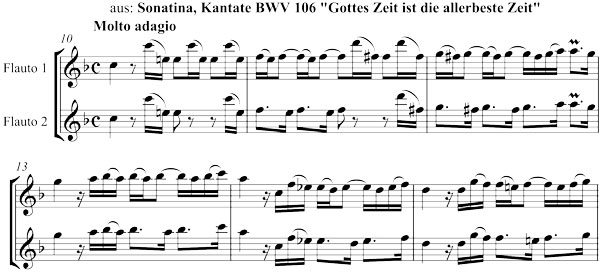
Arnstadt, view of the city. Copperplate engraving, Merian 1650. Source: Collection of the Bachhaus Eisenach/Neue Bachgesellschaft.
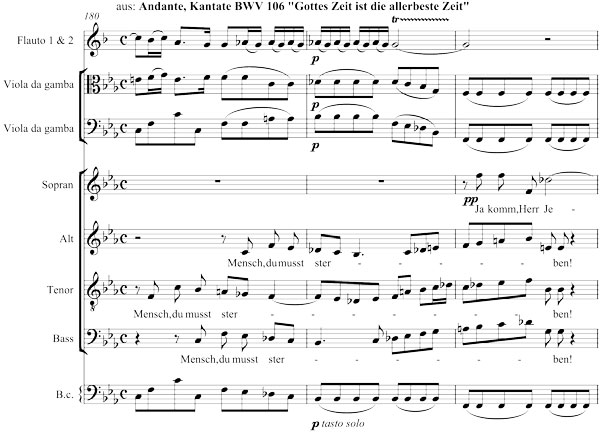
From Andante, Cantata BWV 106 “Gottes Zeit …”: Bach illustrates the text with tonal colouring: the low voices of the choir and a "tasto solo" bass are joined by recorders playing low alternating notes in unison followed by a weak low trill.
Very similar – and for us strangely low – is the scoring of the recorder parts in the Cantata “Gott ist mein König” BWV 71, composed for the induction of a new council on 4/2//1708 (Ratswechsel). Again recorders with a strong lower range will have been used. According to Bach’s score the recorders - together with the other woodwind parts and a single ‘cello - played in the low pitch Kammerton in D major; the other parts were notated in C major Chorton (choir pitch). Today the size of the recorders will depend on whether the piece is performed in a common unified pitch: if performed in D major, treble recorders can be used; in C major, recorders in E-flat could play from the original parts, or tenor recorders could transpose them down a tone. It is interesting how Bach allows the quiet recorders to be audible in this antiphonal festive piece by making use of spatial segregation, despite the large numbers of instruments involved. The orchestra consisted of three trumpets: timpani, strings, two oboes and bassoon, two recorders and separate violoncello piccolo, choir, and organ basso continuo. In the powerful opening tutti the use of recorders is quite sophisticated: they provide the final stage of the echo after trumpets and oboes. They reappear in the fourth movement in the bass arioso “Tag und Nacht” (Day and Night) where they play a duet with the oboes and lose some of their minor role. Several tutti sections follow a powerful aria for alto and trumpet. The recorders are equal members of the ensemble: they repeat oboe and choir motifs, copy melody lines but also have independent phrases and have the last word with a jump up a fourth. The success of this music was evident; it was to be Bach’s first printed work.
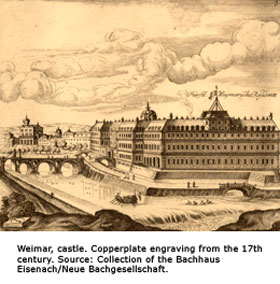
JohanSebastian Bach in Weimar: 1708–1717
Bach’s new position in Weimar (1708–17) made it compulsory for him – especially following his promotion to “Konzertmeister” in March 1714 – to compose at least one piece of church music per month. His cantatas now have the soloistic elements - recitatives and da capo arias - of the Neapolitan opera. Recorders are being used occasionally but they now have relatively higher tessituras and more varied demands are made on them. The instruments must have changed.
At Weimar, the wide difference in pitch between the strings, playing with the organ at Chorton, and the Kammerton pitch of the wind instruments is remarkable. There is almost always a minor third between them, requiring two key signatures in every piece.
The so-called Hunting Cantata, “Was mir behagt, ist die muntere Jagd”, BWV 208, was composed to mark the birthday of Count Christian von Weißenfels on 23/2/1713, and was re-used in Leipzig for the birthday of King Friedrich August of Saxonia. Bach then re-used some parts of it again in his later Leipzig cantatas. Recorders appear only once, in a characteristic manner; the two treble recorders underline the soothing pastoral atmosphere in the well-known aria for soprano “Schafe können sicher weiden” (Sheep may safely graze), sung by Pales, the goddess of flocks and shepherds. There is no difference in pitch as it wasn’t performed with the organ in high Chorton. Thus it can easily be performed on two treble recorders.
The “concerto” (nowadays referred to as a cantata) “Himmelskönig sei willkommen” BWV 182 was Bach’s first religious composition in Weimar, written for Palm Sunday, on the 25/3/1714. It begins with an introductory instrumental sonata in the style of an overture, with dotted rhythms, where a concertante treble recorder and violin play above a pizzicato ensemble. A choir follows with the recorder playing a tutti part. The motifs of the grand aria “Leget euch dem Heiland unter” for alto and recorder obbligato are impressively presented at two alternating tempi. In the chorale, the recorder (at the octave) and the violin support the soprano part. The recorder again leads the final lively tutti for choir.
Because of the pitch difference in Weimar the treble recorder plays a minor third higher than the voice and organ continuo. The recorder part goes up to a’’’ {where a’ is the A above middle C} and uses g-flat’’’, a difficult note on modern copies of historical instruments. These notes were probably not very common even at that time and Bach’s use of them may even have been quite progressive. It is very likely that German instrument makers modified the French baroque recorders by changing their strong low and enriching their higher register. Some original instruments show such properties: the shape of the bore allows these notes to be played without covering the bell. Unfortunately copies of these instruments are still not available nowadays. As there is no mention of the use of the highest register in contemporary literature and fingering charts before 1730, one can assume that both Bach and Telemann (who was proficient on the treble recorder and exposed it even further in some of his compositions) used the high recorder register in their compositions in an ambitious and even experimental way. It should be borne in mind that Bach and Telemann were friends; also that Telemann visited Bach on 10/3/1714 to be godfather to Bach’s son Carl Philipp Emanuel. The two composers may just have talked shop about advanced recorder playing techniques ….
Ten years later BWV 182 was re-used and re-worked to celebrate Maria’s Annunciation (the recorder part remained) and both versions have survived. For practical reasons the Leipzig version is the one usually performed these days.
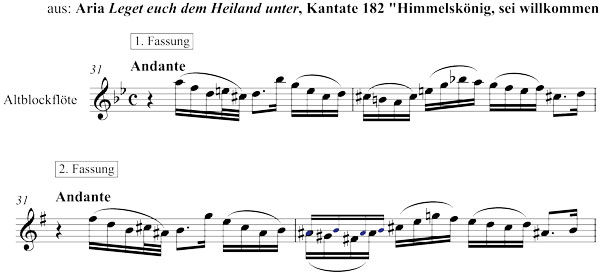
From Aria "Leget euch dem Heiland unter", Cantata 182 “Himmelskönig, sei willkommen”: a)1st version, b) 2nd version: in the second version Bach changed some notes in the treble part in order to avoid awkward fingering combinations.
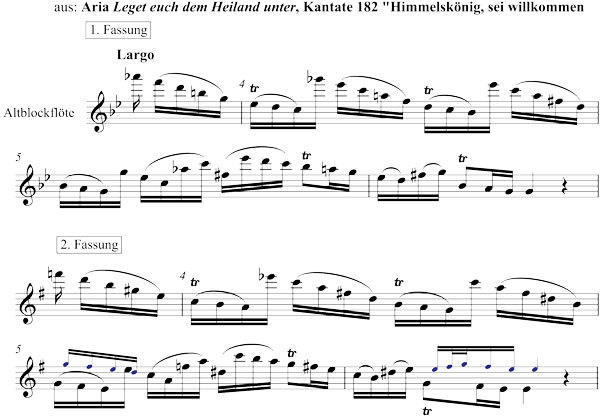
From Aria "Leget euch dem Heiland unter", Cantata 182 “Himmelskönig …”:
a) 1st version b) 2nd version; 1st and 2nd version in comparison: because the parts went too low Bach sketched an alternative line. The original melody however corresponds better to the words of the aria.
Bach describes his cantata “Tritt auf die Glaubensbahn” BWV 152, composed for the Sunday after Christmas 1714, as a concerto with solo parts. It begins purely instrumentally – which in the context of this research is unique – with a short slow introduction and a permutation fugue for treble recorder, oboe, viola d’amore, viola da gamba and organ basso continuo. The aria for soprano voice “Stein, der über alle Schätze” is accompanied by the whole ensemble (without the oboe). In the pastoral duet between soprano and bass (a dialogue between Jesus and the Soul) the melody instruments play in unison in a charming mixture of timbres. Because of the pitch difference between the instruments Bach again had to notate the work in two different keys: the two voice parts, the organ and viola da gamba are in E minor, the other instruments in G minor. Nowadays, if the work is to be performed in G minor, the recorder players can use the original notation. In E minor, a voice flute in D must be used: if it plays the original part in G minor, but using treble fingering, the music will sound in E minor.
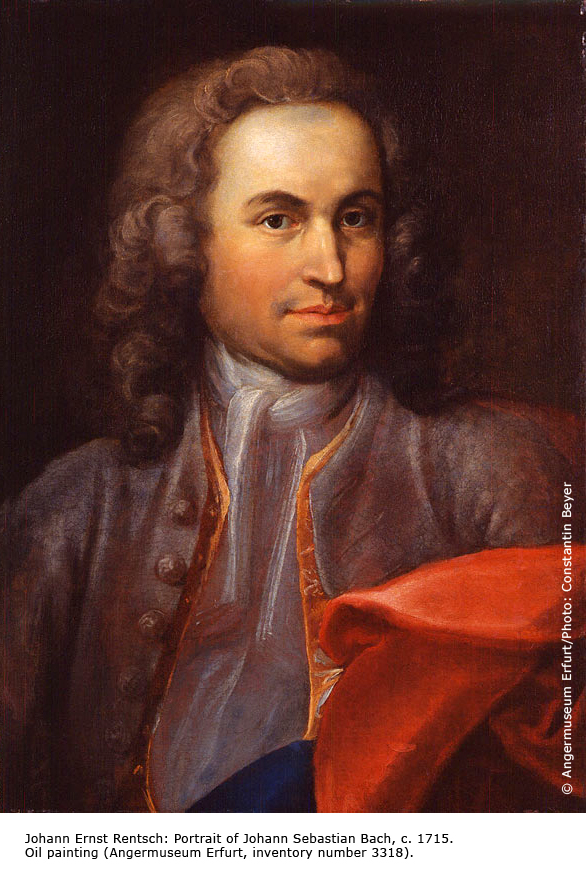
The cantata “Komm, du süße Todesstunde” BWV 161 (first version presumably from 27/9/1716) again has parts a minor third apart. The work is at choir pitch in C, the recorders play in E-flat Kammerton. Performing the piece in a unified modern pitch the original treble parts must be played on voice flutes in d’.
Two treble recorders accompany the introductory aria for alto voice with yearning sequences in thirds and sixths. They resurface with more dramatic gestures in the richly scored alto recitative when they imitate the death bell as they repeatedly do in Bach’s compositions. In the subsequent choir section, which summarises what has happened, the recorders play hurried semiquavers again and again and twice reach the difficult semitone above second octave. In the concluding chorale the recorders play a spectacular, “strangely wandering” (Spitta) section in florid unison. For a later performance in Leipzig on 2/2/1735 the work was set in a unified pitch in C major, and the recorders were replaced by flutes, presumably because the parts then went too low.
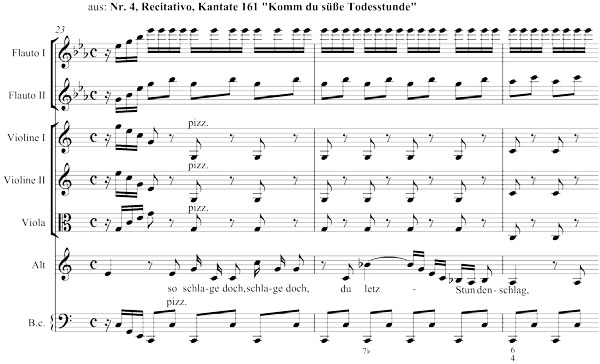
From No.4, Recitativo, Cantata 161 “Komm du süße Todesstunde” :
imitating the sound of the funeral bell: the 1st recorder plays high repetitive notes to the strings’ pizzicato on low open strings.
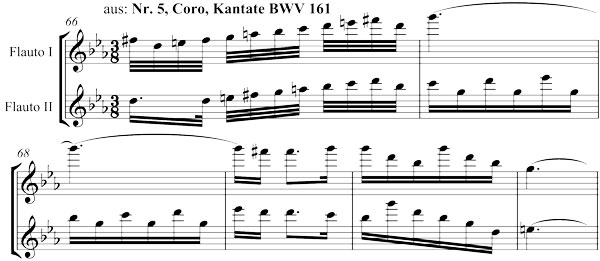
Bach’s musicians must have used treble recorders capable of producing top F sharp without covering the bell.
Bach’s contract in Weimar presumably ended because he felt overlooked when the position of Kapellmeister came up, and he handed in his notice. The files are quite amusing to read: he was arrested due to his stubborn insistence that he wanted to be dismissed, then freed four weeks later and released from his contract.
JohanSebastian Bach in Köthen. 1717–1723
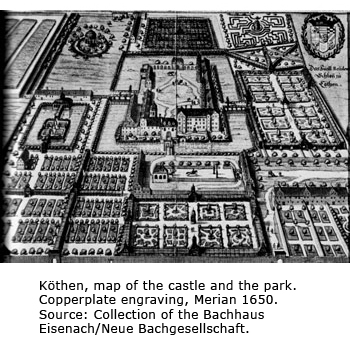
There are no surviving cantatas involving recorders from Bach’s next employment as Kapellmeister in Köthen. However, as far as we are aware he used the instrument at least twice in concertante compositions. The dedication date, 24/3/1721, given on the title page of the collection of scores for the Brandenburg concertos is treated as their date of origin.
Brandenburg Concerto no. 2 in F major, BWV 1047, combines an ensemble of soloists, consisting of trumpet, treble recorder, oboe and violin, and a string ripieno. It requires a proficient soloist and a rich sounding instrument responding well in all registers. This work, which is described in detail elsewhere and still very popular, is probably Bach’s most famous concertante composition for solo recorder. The reason that it is not performed more frequently may be the fiendishly difficult trumpet part.
A special performance technique needs to be pointed out (often notated differently in more recent editions): the tremulant; this is a special playing technique of repeated notes under a slur marking (related to the rhythmically clearly notated regular bow vibrato for stringed instruments). On wind instruments these notes are not to be articulated by the tongue but should be marked with pulses from the diaphragm – but in this instance piano.
Brandenburg Concerto no. 4 in G major BWV 1049 is very popular nowadays. It uses two treble recorders and a violin as solo instruments. The title asks for “due Fiauti d’Echo”, which many authors have wondered about. Indeed there are a few isolated suggestions that echo flutes must have existed in England. It is presumed that these would be two recorders mounted next to each other in the same key but voiced in different ways, so that one recorder sounds quieter than the other one. However neither instruments nor compositions appear to have survived in England. Thus the instrumentation of Bach’s score is unique. An instrument in the collection of the University museum in Leipzig, fitting the above description, is not suitable for Bach’s composition. It may well be that the composer was relating to something that wasn’t actually put into practice where he lived. It is perhaps because of this that he designates the parts “Fiauto 1mo” and “Fiauto 2do” – very clearly calling for treble recorders, which is also evident by the way the parts were written. It is only in the second movement that there are some echo effects, as the themes alternate between tutti and soli. But even here the echo does not have to be created artificially by the flautists. It is the structure, rather than the playing technique that creates the echo. Differences in volume appear naturally by the alternating timbre of the different instruments. Bach marks these sections as forte in the tutti sections and piano for the three soloists; but he also does this in other compositions with similar structures where an echo is not explicitly called for.
Seventeen years later Bach reworked this concerto into the Concerto for Harpsichord in F-major BWV 1057, keeping the recorders.
Part 2 will look at Bach’s time in Leipzig where he composed more works that include recorders.
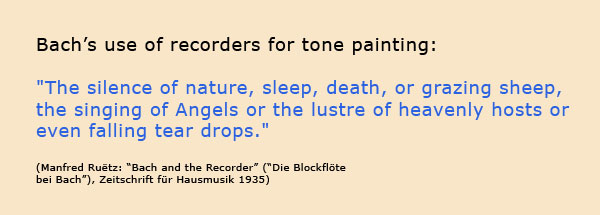
Literature:
Ulrich Prinz: J.S. Bachs Instrumentarium – Originalquellen, Besetzung, Verwendung. Schriftenreihe der Internationalen Bachakademie Stuttgart, Band 10, Bärenreiter Verlag 2005
This article originally appeared in German in Windkanal 2, 2005, and is reprinted with the kind permission of the author and publishers. It has been translated for The Recorder Magazine by Ursula Burchette with the support of Andrew Robinson, Kathryn Bennetts and Peter Bowman.



 English
English











